Hyperprolactinemia
PROCLACTIN • Is a polypeptide hormone containing 198 amino acids and having a molecular weight of 22,000 daltons. • It curculates in different molecular sizes- a (small) form (mol wt 22,000), and a (big) form (mol wt 50,000), and an even larger (big-big) form (mol wt > 100,000). • The small form is biologically active, and about 80% of the hormone secreted is in this

Hyperprolactinemia
Dr. Ashraf Fouda
F.E.B.O.G.
Obs./Gyn. Consultant

PROCLACTIN
• Is a polypeptide hormone containing 198 amino acids and having a molecular weight of 22,000 daltons.
• It curculates in different molecular sizes- a (small) form (mol wt 22,000), and a (big) form (mol wt 50,000), and an even larger (big-big) form (mol wt > 100,000). • The small form is biologically active, and about 80% of the hormone secreted is in this
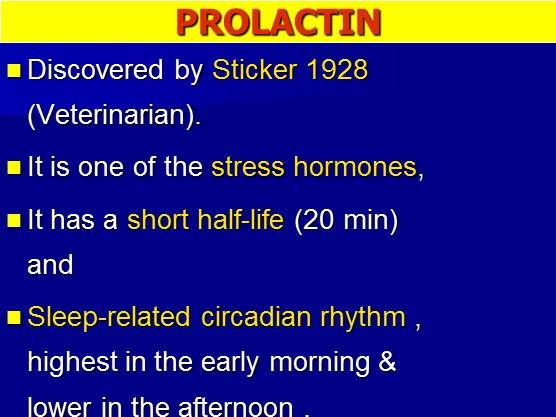
PROCLACTIN
• Discovered by Sticker 1928 (Verterinarian).
• It is one of the stress hormones,
• It has a short half-life (20 min) and
• Sleep-related circadian rhythm, highest in the early morning & lower in the afternoon
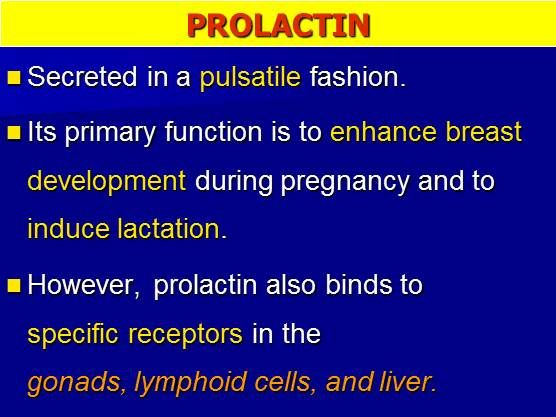
PROCLACTIN
• Secreted in a pulsatile fashion.
• Its primary functionis to enhance breast development during pregnancy and to induce lactation.
• However, prolactin also binds to specific receptors in the gonads, lymphoid cells, and liver.
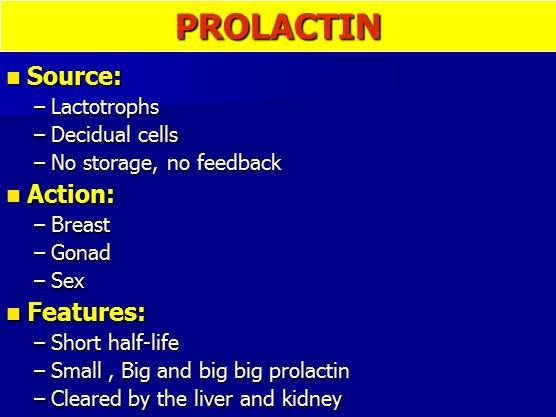
PROCLACTIN
• Source:
- Lactotrophs
- Decidual Cells
- No storage, no feedback
• Action:
- Breast
- Gondad
- Sex
• Features:
- Short half-life
- Small, Big and big big prolactin
- Cleared by the liver and kidney

PROCLACTIN
• Estrogen stimulates the proliferation of pituitary lactotroph cells, resulting in an increased quantity of these cells in premenopausal women, especially during pregnancy.
• Normal fasting values generally are less than 30 ng/ml depending on the individual laboratory.
• Hyperprolactinemia is a condition of elevated
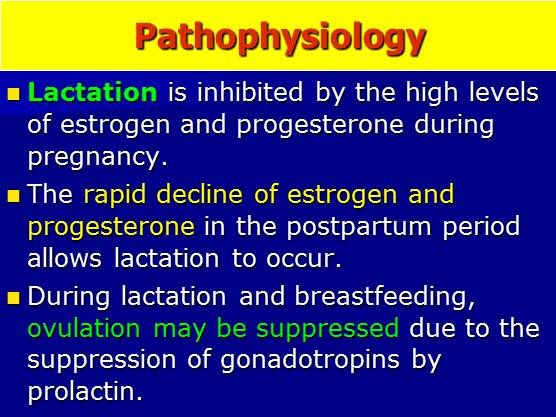
Pathophysiology
• Lactation is inhibited by the high levels of estrogen and progesterone during pregnancy.
• The rapid decline of estrogen and progesterone in the postpartum period allows lactation to occur.
• During lactation and breastfeeding, ovulation may be suppressed due to the suppression of gonadotropins by the prolactin.

Pathophysiology
• Dopamine (Prolactin Inhibiting Factor PIF) has the dominant influence over prolactin secretion.
• Secretion of prolactin is under tonic inhibitory control by dopamine, which acts via D2-type receptors located on lactotrophs.
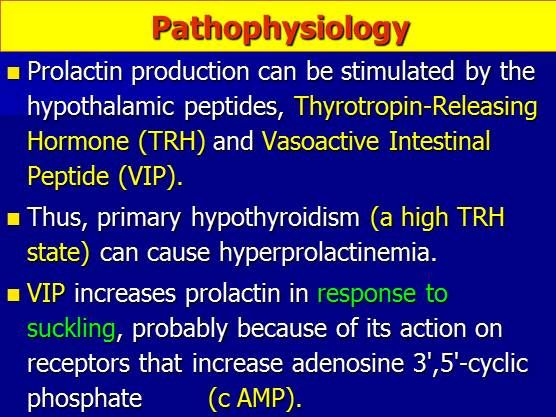
Pathophysiology
• Prolactin production can be stimulated by the hypothalamic peptides, Thyrotropin-Releasing Hormone (TRH) and Vasoactive Intestinal Peptide (VIP).
• Thus, primary hypothyroidism (a high TRH state) can cause hyperprolactinemia.
• VIP increases prolactin in response to suckling, probably because of its action on receptors that increase adenosine, 3', 5'-cyclic phosphate (cAMP).
s

Manifestation of hyperprolactinemia
In Females:
• Galactorrhea (Non-puerperal lactation)
- Unilateral or bilateral
- Free floating or expressive
- Continuous or intermittent
• Ovulatory dysfunction
- Oligo-ovulation
- LPD
- Anovulation
• Menstrual Troubles
- Oligomenorrhea
- Hypomenorrhea
- Amenorrhea

Manifestation of hyperprolactinemia
• Osteoporosis
• Nervous manifestations (headache)
• Visual field defects (Bitemporal Hemianopia)
• Hirsutism
In Men
• Impotence
• Oligospermia
• Gynecomastia
• Headache
• Osteoporosis
• Visual field defects

Hyperprolactinemia
• is present in:
• 15-20% of cases involving secondary amenorrhea or oligomenorrhea.
• 30% of cases involving galactorrhoea or infertility.
• 75% of cases involving both amenorrhea & galactorrhoea.

Causes of hyperprolactinemia
Physiologic Factors
– Pain
– Nipple stimulation
– Pregnancy
– Pelvic examination
– Exercise
– Sleep
Drugs
– Dopamine-antagontists
– Dopamine-depleting agents
– Narcotics
Pathologic factors
– Hypothalamus
– Pituitary
– Thyroid
Idiopathic hyperprolactinemia

Drug-induced hyperprolactinemia
Dopamine-depleting agents:
• Aldomet
• Resperine
Dopamine receptor atagonist:
• Chlorpromazine
• Promazine
• Butyrophenone (haloperidol)
• Metoclopramide (primperan)
• Domperidone (motilium)
• Sulpiride (dogmatyl)

Drug-induced hyperprolactinemia
- Lactotroph stimulator
• estrogen
• TRH
- Narctoics
• Morphine
• Codeine
Methodone
- Amphetamine
- H2-receptor blocker
• Cimetidine (Tagamet)
• Ranitidine (Zantac)

Hypothalamic Causes
• Craniopharyngionma (Rathke's pouch tumor) being the best example.
• Grossly they may be cystic, solid, or mixed, and calcification is usually visible on x-ray examination.

Pituitary Causes
• Various types of pituitary tumors, lactotroph hyperplasia, and the empty sella syndrome can be associated with hyperprolactinemia.
• 80% of all pituitary adenomas secrete prolactin.
• The most common pituitary tumor associated with hyperprolactinemia is the prolactinoma, defined as
1. Microadenoma if its diameter is less than 1 cm and as
2. Macroadenoma if is larger.

Empty sella syndrome
• An intrasellar extension of the subarachnoid space resulting in compression of the pituitary gland and an enlarged sella turcica that may be associated with galactorrhea and hyperprolactinemia.

Hypothyroidism
• About 3% to 5% of individuals with hyperprolactinemia have hypothroidism, and thus TSH, the most sensitive indicator of hypothyroidism, should be measured in all individuals with hyperprolactinemia.

Indications for Prolactin assay
• Secondary amenorrhea
• Galactorrhea
• Ovulatory dysfunction
• Unexplained infertility
• Oligospermic men
Not all hyperprolactinemic patients display galactorrhea and galactorrhea can be seen with normal prolactin level

Indications for sella evaluation
• Prolactin level > 100 ng/ml
• Nervous manifestations
• Amenorrhea galactorrhea:
– Resistant to treatment
– Associated with negative Progesterone Withdrawal test
.

Galactorrhea
• It is important to distinguish secretions that result from intrinsic breast disease from true galactorrhea.
• Galactorrhea is defined as the non-pueperal secretion of milk and can be confirmed if necessary by visualizing fat droplets in secretions using low power microscopy.

Galactorrhea
• Galactorrhea is rarely seen in intrinsic breast diseases, which are usually associated with purulent, clear, yellow (serous), multicoloured or sanguinous discharge.

Galactorrhea
• Isolated galactorrhea, with normal menses and normal serum prolactin levels, has been estimated to occur in up to 20% of women at some point in their lives.

Galactorrhea
• Hyperprolactinemia is found in 30% of women with amenorrhea, and in 75% of women who have both amenorrhea and galactorrhea.
• Thus, measurement of serum prolactin levels is indicated in all cases of galactorrhea.

If no obvious cause is identified or if a tumor is suspected, MRI should be performed.
• A prolactinoma is likely if the prolactin level is greater that 250 ng/mL and less likely if the level is less than 100 ng/mL.
• Prolactin-secreting adenomas are divided into 2 groups:
• (1) Microadenomas (more common in premenopausal woment), which are smaller than 10 mm and
• (2) Macroadenomas (more common in men and postmenopausal women), which are 10 mm or larger.

no obvious cause is identified or if a tumor is suspected, MRI should be performed.
• If the prolactin level is greater than 100 ng/mL MRI imaging is performed to rule out a prolactin-producing tumor.
• When the underlying cause (physiologic, medical, pharmacologic) cannot be determined and an MRI does not identify an adenoma, idiopathic hyperprolactinemia.

Macroprolactinemia
• Is the apparent increase in serum prolactin without symptoms.
• Serum prolactin molecules can polymerize and subsequently bind to immunoglobuin G (IgG).
• This form of prolactin is unable to bind to prolactin receptors and exhibits no systemic response.
• In the asymptomatic patient with hyper prolactinemia, this condition should be considered

Macroprolactinemia
• If this condition is suspected, specfic serum immunoassays must be performed to detect this form of prolactin.
• Women with macroprolactinemia are able to conceive.
• This condition generally requires no treatment.

Imaging Studies
• Although modern high-speed helical CT scanners produce very detailed images, MRI is the imaging study of choice.
• MRI can detect adenomas that are as small as 3-5 mm.

Management
• Remember that ther are four main known causes of hyperprolactinemia
1. Pregnancy
2. Drug use
3. Hypothyroidism
4. Pituitary tumors
• Remember that it is esstential to treat asymptomatic hyperprolatinemic women but follow-up is a must.
• Remember that the problem is never over once pregnancy occurs

Medical treatment
• Indications for treatment include the presence of significant symbols such as:
1. Disabling galactorrhea,
2. Amenorrhea, and infertility;
3. Presence of visual field defect and cranial nerve palsy; and
4. Abnormal test results such as detection of a pituitary tumor,
5. Diminished libido,
6. Osteopenia, or osteoporesis.

Medical treatment goals
1. Suppressing prolactin secretion and its clinical and biochemical consequences,
2. Reducing the size of the prolactinoma, and
3. Preventing it progression or recurrence.

Dompamin agonists
• Are the preferred treatment for most patients with hyperprolactinemic disorders.
• These agents are extremely effective in:
1. Lowering serum prolactin levels,
2. Eliminating galactorrhea,
3. Restoring gonadal function, and
4. Decreasing tumor size

NB: Parlodel ↑ GH in healthy and ↓ it in acromegalics

Bromocriptine
• Is a semisynthetic ergot derivative of ergoline, a dopamine D2-receptor agonist with agonist and antagonistic properties on D1 receptors.
• Because of its short half-life (3.3 hours), bromocriptine may require multiple dosing throughout the day.
• Approximately 12% of patients are unable to tolerate this medication at therapeutic dosages.

Bromocriptine
• The most common adverse effects are:
Nausea and vomiting:
Headache,
Nasal stuffiness,
Drowsiness,
Fatigue,
Abdominal pain,
Leg cramps,

Bromocriptine
• To minimize these symptoms the initial dose should be taken in bed with food at nighttime.
• Most of these reactions are mild, occur early in the course of treatment, and are transient.
• To reduce the adverse symptoms, the does should be gradually increased every 1 to 2 weeks until prolactin levels fall to normal.
• The usual therapeutic dose is 2.5 mg twice or three times a day, but larger doses are sometimes used when a macroadenoma is present.

Bromocriptine
• To minimize side effects, bromocriptine usually is started at a low dosage and increased gradually.
• Vaginal administration may decrease the incidence of side effects.
• Is the preferred agent in patients with hyperprolactin- induced anovulatory infertility.

Bromocriptine
• The safety of fetal exposure to has been evaluated extensively, and this it is not associated with increased rates of spontaneous abortion, fetal malformation, multiple pregnancies, or adverse effects on postnatal development. (Category B).
• Bromocriptine treatment should be discontinued when pregnancy is confirmed to limit fetal exposure to the medication.

Drug safety in Pregnancy
B

Cabergoline
• Cabergoline is an ergoline derivative with a high affinity and selectivity for D2 receptors.
• Unlike bromocriptine, cabergoline has low affinity for D1 receptors.
• It has half-life of approximately 65 hours, allowing once-or twice-weekly dosing.

Cabergoline
• Cabergoline is significantly more effective than bromcriptine in the normalizing serum prolactin levels and restoring gonadal function.
• It also is better tolerated than bromocriptine, particularly with regard to upper and gastrointestinal symptoms and patient compliance

Cabergoline
• It is much more expensive.
• It is oftent used in patients who cannot tolerate the adverse effects of bromocriptine or in those who do not respond to bromocriptine.

Cabergoline
• Although no detrimental effects on fetal outcomes have been reported in more than 300 pregnant women taking cabergoline, the current recommendation is to discontinue cabergoline one month before conception is attempted. (Category B).

Surgical Care
• General indications for pituitary surgery include:
1. Patient drug intolerance,
2. Tumor resistant to medical therapy,
3. Persistent visual-field defects in spite of medical treatment, and
4. Patients with large cystic or hemorragic tumors.
5. Trans-sphenoidal surgery is the conventional procedure.

Radiotherapy
• Stereotactic radiosurgery has become more popular because MRI allows more accurate resolution and dose planning.
• Radiotherapy should be considered in patients with macroadenomas who are resistant to or intolerant of medical therapry and in whom surgery has failed.

Key clinical recommendation
• Cabergoline is more effective an better tolerated than bromocriptine. (Grade B)
• Dopamine agonists are the treatment of choice in most patients with hyperprolatinemic disorders. (Grade B)

Key clinical recommendation
• Bromocriptine is the drug of choice when treatment is aimed at hyperprolactin-induced anovulatory infertility. (Grade C)
• MRI of the pituitary fossa should be performed if the serum prolactin level is significantly elevated or if there is any suspicion of a pituitary tumor. (Grade C)

Key Points
• Estrogen stimulates prolactin release but blocks its action at the receptor in the breast.
• Physiologic stimuli for prolactin release include breast and nipple palpation, exercise, stess, sleep and the noonday meal.
• The main symptoms of hyperlactinemia are glactorrhea and amenorrhea, the latter caused by alteration in normal gonadotrophin-releasing hormone (GnRH)

Key Points
• Hyperprolactinemia is present in 15% of all anovulatory women and 20% of woment with amenorrhea of undetermined cause.
• 70% of all women with galctorrhea have hyperprolactinemia, but almost 90% of women with galactorrhea, amenorrhea, and low estrogen levels have hyperprolactinemia.

Key Points
•Pathologic causes of hyperprolactinemia include:
1. Pharmacologic agents (tranquilizers, narcotics, and antihypertensive drugs),
2. Hypothyroidism,
3. Chronic renal disease,
4. Chronic neurostimulation of the breast,
Hypothalamic disease, and
6. Pituitary tumors (Prolactinoma, Acromegaly, Cushing's disease).

Key Points
•About 3% ti 5 % of individuals with hyperprolactinemia have hypothyroidism.
• About 80% of all pituitary tumors secrete prolactin.
• About 25% of individuals with Acromegaly and 10% of those with Cushing's disease have hyperprolactinema. • About 10% of individuals with an enlarged sella have the empty sella syndrome.

Key Points
• Autopsy studies reveal that prolactinomas are present in about 10% of the population.
• About 50% of women with hyperprolactinemia will have prolactinoma, as will nearly all of those with prolactin levels greater that 200 ng/ml.
• About 20% of women with galactorrhea and 35% of thos with amenorrhea and galactorrhea have prolactinomas.

Key Points
• About 70% of women with hypreprolactinemia, galactorrhea, and amenorrhea with low estrogen levels will have a prolactinoma.
• Women with regular menses, galactorrhea, and normal prolactin levels do not have prolactinomas.
• About 13% of women with prolactinomas do not have galactorrhea.

Key Points
• Most macroadenomas enlarge with time; nearly all microadenomas do not.
• The initial operative cure rate for microadenomas is about 80% and for macroadenomas 30%, but the long-term recurrance rate is at least 20% for each.
• Most frequent side effect of bromocriptine are orthostatic hypotension, nausea, and vomiting.

Key Points
• In hyperprolactinemia and no macroadenoma, bromocriptine treatment returns prolactin levels to normal in 90%, induces ovulatory cycles in 80%, and eradicates glactorrhea in 60%.
• After 1 year bromocriptine treatment, prolactin levels remain normal in 11% of women with microadenomas;
• After 2 years permanent remission reaches 22%.
After longer use, remissions of 50% have

Key Points
• Bromocriptine shrinks 80% to 90% of macroadenomas.
• When pregnancy occurs in women with microadenomas, less than 1% have visual field changes, tumor enlargement, or neurologic signs; about 20% of women with microadenomas have such adverse changes.
• Pregnancy increases the likeihood that prolactin levels will decrease or become normal over time.

Key Points
• Estrogen replacement therapy or oral contraceptives will not stimulate growth of prolactin-secreting microadenomas and can be used for therapy of hyperprolactinemia and hypoestrogenism.

Key Points
• Bromocriptine induction of pregnancy is not associated with an increased risk of congenital abnormalities, spontaneous abortion, or multiple gestation.
• About 85% of patients with prolactinomas have no change in prolactin levels or tumor size after delivery, 10% improve, and 5% worsen.

Key Points
• The most frequent cause of mildly elevated prolactin levels is stress.
• The best modality to diagnose pituitary adenomas or empty sella syndrome is magnetic resonance imaging (MRI).
• The natural history of nearly all microprolactinomas is to stay the same size, with adverse menstrual problems resolving spontaneously in about one fourth of patients.

Key Points
• Surgical treatment of prolactinomas is recommended only for patients who fail to respond or do not comply with medical management.
• For women who develop side effects with oral bromocriptine, vaginal administration usually alleviates the problem.
• Cabergoline appears to be more effective and better tolerated than bromocriptine.

Thank You
S1E4: Dr. Kristina Adams-Waldorf: Pandemics, pathogens and perseverance
July 16th 2020This episode of Pap Talk by Contemporary OB/GYN features an interview with Dr. Kristina Adams-Waldorf, Professor in the Department of Obstetrics and Gynecology and Adjunct Professor in Global Health at the University of Washington (UW) School of Medicine in Seattle.
Listen
